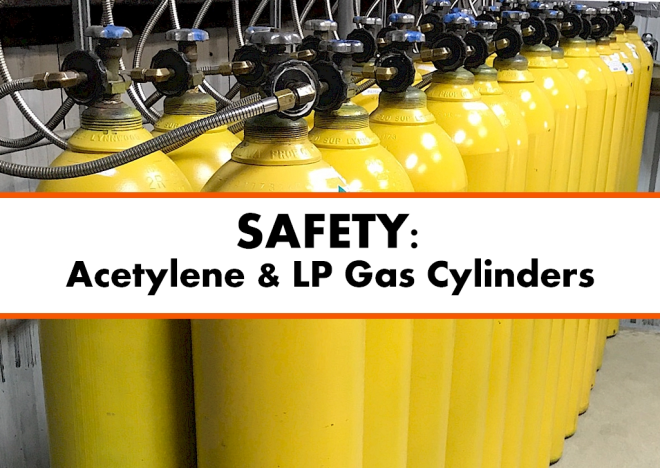Safety Topic: Acetylene and LP-Gas Leaking Cylinders
Oxy-fuel welding carries with it the potential for serious accidents. Welding sparks are a fire hazard. The improper maintenance, handling, and monitoring of cylinders is responsible for the majority of accidents. Following are the guidelines for checking leaks on Acetylene and LP Gas Cylinders.
Acetylene and LP-Gas Leaking Cylinders
General Safety Precautions
Never use a flame to test for leaks on any flammable gas cylinder, valve, hose or connection. If a leak is suspected, check by brushing or spraying a soapy water or leak detection solution on the suspected area. If the leak can be stopped by normal means, such as closing the valve or tightening the fitting or connection, proceed with caution.
If the leak cannot be stopped, move the cylinder and/or related equipment outdoors and away from any source of ignition. Isolate and post a sign in the area where the cylinder is placed to ensure personnel do not approach the cylinder with an open flame or any other type of ignition source. With any flammable gas leak, your first consideration must be the safety of all personnel. When appropriate, execute your emergency evacuation plan to assure your personnel are out of danger.
Acetylene Cylinders
Since acetylene and air mixtures are flammable and explosive in almost all proportions, precautions must be taken to prevent and detect acetylene leakage. All connections must be kept tight and hoses maintained in good working condition. If leakage is suspected, brush or spray the suspected leakage area with soapy water or with a leak detection solution. Bubbles of escaping acetylene through the soap film will indicate a leak.
Acetylene cylinders are equipped with fusible metal plugs having a melting point between 208° F and 220°F, which may be located in the top and bottom heads of the cylinders, or in the cylinder valve on 10 ft³and 40ft³ cylinders. Although these fuse plugs are tested for leakage, there are occasions where they begin to leak.
If an acetylene cylinder begins to leak from any metal pressure relief device or from the valve, even when the valve is closed, and the leaking acetylene has not ignited:
Move the cylinder outdoors away from any possible source of ignition.
Plainly tag the cylinder as having an unserviceable valve or fusible plug relief device.
Place a sign in close proximity to the cylinder warning persons against approaching the cylinder with cigarettes or any other type of ignition sources.
Once the acetylene cylinder has been properly isolated outdoors, as described above, customers should notify their supplier immediately giving the particulars of the defect, as far as known, and follow their instructions.
LP Cylinders
LP-gas leaks can be detected by applying a soapy water solution to areas of suspected leaks. Again, never use a flame to test for a leak. Frost formation around connections or around valve stems is a good indicator of a liquid leak. If a leak does occur, keep unauthorized personnel away from the area and eliminate all possible ignition sources.
If LP-gas is escaping and not on fire, the following steps can be taken provided they can be done without risk to personnel.
LP-gas is escaping without fire:
An attempt should be made to close a valve that will stop the flow of gas. Small lines, such as copper tubing, can be flattened or crimped to stop the flow of gas. If possible, the container should be moved to a safe place.
Water spray is effective in dispersing LP-gas vapor.
If a valve is not available to stop the flow, an expert emergency responder may consider
igniting the escaping gas from a safe distance, upwind of the leak. Be certain all personnel are sufficiently clear of the area. After ignition, allow the fire to burn, applying sufficient water to cool the container and any exposed pipe.
If LP-gas is escaping and on fire:
Call your local fire department immediately.
Fire should not be extinguished unless the leakage can be stopped immediately.
The container vapor space and appurtenances should be kept cool with water spray applied from the upwind direction.
Dry chemical or carbon dioxide extinguishers are suitable for putting out small LP-gas fires.
The extinguishing agent should be directed at the base of the flame.
Shooting holes in an LP gas tank that is involved in a fire does not serve any useful purpose and should not be permitted. It may cause the fire to become more serious.
Ordinarily, no attempt should be made to move any tank involved in a fire because usually little will be gained in reducing the hazard.
A tank involved in a fire should never be dragged because valves or appurtenances on the tank might be damaged.
See what can happen when a leaking oxy-fuel cylinder is transported in an unventilated space.

